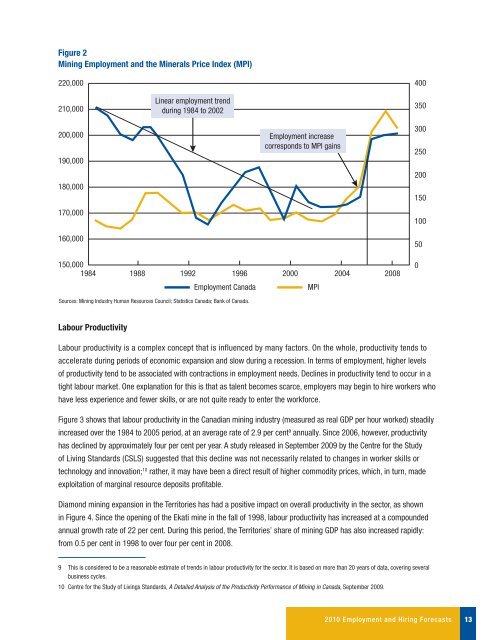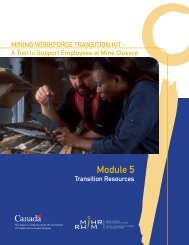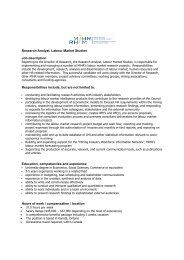Canadian Mining Industry Employment and Hiring Forecasts - MiHR
Canadian Mining Industry Employment and Hiring Forecasts - MiHR
Canadian Mining Industry Employment and Hiring Forecasts - MiHR
Create successful ePaper yourself
Turn your PDF publications into a flip-book with our unique Google optimized e-Paper software.
Figure 2<br />
<strong>Mining</strong> <strong>Employment</strong> <strong>and</strong> the Minerals Price Index (MPI)<br />
220,000<br />
210,000<br />
Linear employment trend<br />
during 1984 to 2002<br />
400<br />
350<br />
200,000<br />
190,000<br />
180,000<br />
170,000<br />
160,000<br />
<strong>Employment</strong> increase<br />
corresponds to MPI gains<br />
300<br />
250<br />
200<br />
150<br />
100<br />
50<br />
150,000<br />
1984 1988 1992 1996 2000 2004 2008<br />
<strong>Employment</strong> Canada<br />
MPI<br />
0<br />
Sources: <strong>Mining</strong> <strong>Industry</strong> Human Resources Council; Statistics Canada; Bank of Canada.<br />
Labour Productivity<br />
Labour productivity is a complex concept that is influenced by many factors. On the whole, productivity tends to<br />
accelerate during periods of economic expansion <strong>and</strong> slow during a recession. In terms of employment, higher levels<br />
of productivity tend to be associated with contractions in employment needs. Declines in productivity tend to occur in a<br />
tight labour market. One explanation for this is that as talent becomes scarce, employers may begin to hire workers who<br />
have less experience <strong>and</strong> fewer skills, or are not quite ready to enter the workforce.<br />
Figure 3 shows that labour productivity in the <strong>Canadian</strong> mining industry (measured as real GDP per hour worked) steadily<br />
increased over the 1984 to 2005 period, at an average rate of 2.9 per cent 9 annually. Since 2006, however, productivity<br />
has declined by approximately four per cent per year. A study released in September 2009 by the Centre for the Study<br />
of Living St<strong>and</strong>ards (CSLS) suggested that this decline was not necessarily related to changes in worker skills or<br />
technology <strong>and</strong> innovation; 10 rather, it may have been a direct result of higher commodity prices, which, in turn, made<br />
exploitation of marginal resource deposits profitable.<br />
Diamond mining expansion in the Territories has had a positive impact on overall productivity in the sector, as shown<br />
in Figure 4. Since the opening of the Ekati mine in the fall of 1998, labour productivity has increased at a compounded<br />
annual growth rate of 22 per cent. During this period, the Territories’ share of mining GDP has also increased rapidly:<br />
from 0.5 per cent in 1998 to over four per cent in 2008.<br />
9 This is considered to be a reasonable estimate of trends in labour productivity for the sector. It is based on more than 20 years of data, covering several<br />
business cycles.<br />
10 Centre for the Study of Livings St<strong>and</strong>ards, A Detailed Analysis of the Productivity Performance of <strong>Mining</strong> in Canada, September 2009.<br />
2010 <strong>Employment</strong> <strong>and</strong> <strong>Hiring</strong> <strong>Forecasts</strong><br />
13













